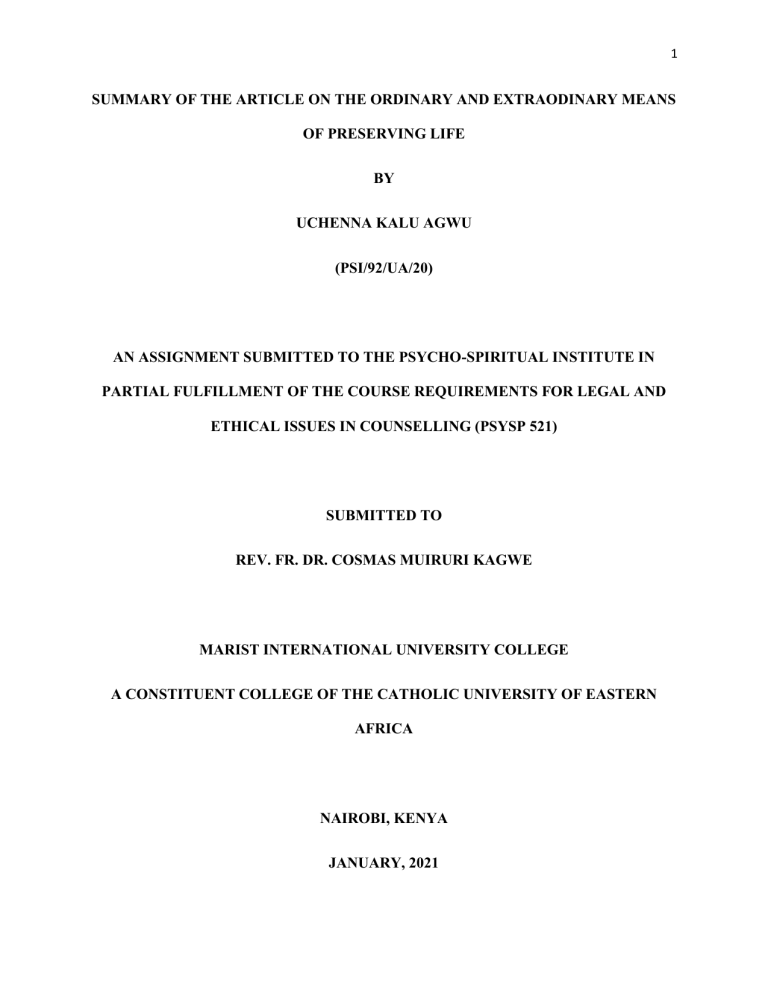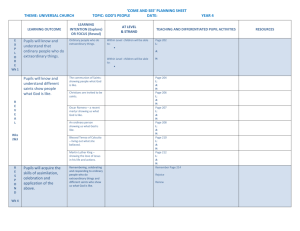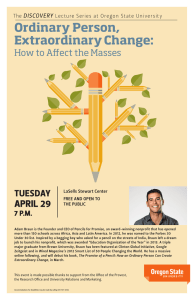
1 SUMMARY OF THE ARTICLE ON THE ORDINARY AND EXTRAODINARY MEANS OF PRESERVING LIFE BY UCHENNA KALU AGWU (PSI/92/UA/20) AN ASSIGNMENT SUBMITTED TO THE PSYCHO-SPIRITUAL INSTITUTE IN PARTIAL FULFILLMENT OF THE COURSE REQUIREMENTS FOR LEGAL AND ETHICAL ISSUES IN COUNSELLING (PSYSP 521) SUBMITTED TO REV. FR. DR. COSMAS MUIRURI KAGWE MARIST INTERNATIONAL UNIVERSITY COLLEGE A CONSTITUENT COLLEGE OF THE CATHOLIC UNIVERSITY OF EASTERN AFRICA NAIROBI, KENYA JANUARY, 2021 2 Introduction The article titled “Ordinary and Extraordinary Means of the Preservation of Life: The Teaching of Moral Tradition” written by Paulina Taboada has its major focus on the explanation of the Church’s teaching in the field of medical ethics. It does this by exploring two aspects of the topic viz; the historical development of the distinction between ordinary and extraordinary means of preserving life and some inadequate interpretations of the Magisterium. The distinction between the ‘ordinary’ and the ‘extraordinary’ means was first made by St. Thomas Aquinas although the two terms were first implored by Domingo Banez in a debate on the moral nature of preserving life. Two conditions characterize the Church’s teaching on the moral duty of preserving health and life. First, the use of common medical treatments to safeguard life. Secondly, that such treatments do not involve a physical or moral impossibility for the patient. When these two conditions are met simultaneously, it is considered as ordinary means, thus morally obligatory but when one of the conditions is missing, it is considered extraordinary and it is morally facultative for the individual (relative norm). Historical Development The genesis of a ‘positive’ moral duty in preserving life can be traced back to the foundation of Christianity. St. Basil has been found to praise medicine as a way of healing the sick while condemning too much concern for the flesh. This had a profound influence on the moralists of the 16th century and their limits of the moral duty of life preservation. Moralists based their teaching on the analysis of St. Thomas Aquinas’ concepts of positive and negative precepts. For Aquinas, there is not just the ‘negative’ obligation of preserving one’s life by not committing suicide, there is also a ‘positive’ or ‘affirmative’ obligation of taking care of one’s life by every possible means. A more systematic development of medical sciences during the Renaissance led to the formal application of these concepts as evident in the works of commentators of Aquinas like Francisco de Vitoria and others. New discoveries in Medicine like surgical amputation challenged moralists to look into what exactly constituted a moral obligation to preserve one’s life especially when these new techniques were available without anesthetics and pain killers. Francisco de Vitoria’s work stands out in distinguishing between the ‘ordinary’ and the ‘extraordinary’ means. He argues that medicine and food are not the same, therefore, if one refuses to eat and dies from it, he incurs a mortal sin but that is not true for someone who does not take medicine to prolong his life. Yet, he 3 adds that if a person is sure that a medication would make him recover and without it would die, he would not be excused from mortal sin. These arguments led Vitoria to assume that a person could be excused from a moral duty to prolong life when there is a condition of moral impossibility, for instance, in a case of an unreasonable cost. With the work of Francisco de Vitoria, the moralists of the tradition described the conditions that make up the nature of the ‘ordinary means’ which include that the means has to be common, easy, and not difficult as well as have the capacity to provide beneficial results according to one’s state of life. On the other hand, the extraordinary means presupposes a physical and moral impossibility. Among the elements of a moral impossibility are severity, excruciating pain, exorbitant cost and exceedingly difficult means. This means that a means of preserving life is considered ‘extraordinary’ if it meets any of these four elements. An extraordinary means of preserving life is simply optional and not compulsory. In determining the moral character of the ordinary and extraordinary means, attention should be focused on both the individual sick person (relative norm) and human beings in general (absolute norm). This is because what may seem ‘ordinary’ or ‘extraordinary’ to one individual may not be the same for another. The second reason is that circumstances may differ even for the same person. The Theological Foundations of the Traditional Teaching The theological foundation of the traditional teaching is based on the virtue of justice. Cardinal Juan argues that the dominion given to man doesn’t include his life in an equal respect. This means that although man has been given a dominion over created things including his life, he is rather to be an administrator than a person who exploits. Moving forward, it was in the 20th century that we saw the inclusion of the traditional teaching in magisterial documents. Pope Pius XII in 1957 made reference to the typical distinction between the ‘ordinary’ and the ‘extraordinary’ means in a speech delivered to a group of anesthesiologists. Also, in 1981, the document of the Sacred Congregation for the Doctrine of Faith on euthanasia referred to the ordinary and extraordinary means. The document explains that it is morally valid to be satisfied with the ordinary means for preserving life that medicine can provide, and that it is also morally valid to reject some treatments that prolong human life in a painful manner in the face of an imminent death. Here, the document uses the terms ‘proportionate’ and ‘disproportionate’ therapies to characterize the distinction. Other documents of the magisterium that make reference 4 to this are the 1981 document of the Pontifical Counsel Cor Unum and the Pontifical Council for the Pastoral Assistance of Health Care Workers published in 1995. Pope John Paul II’s Evangelium Vitae (The Gospel of Life) confirms the traditional teaching by making a distinction between the act of euthanasia and the so-called aggressive methods of medicine. The document argues that to reject any disproportionate medical treatment because of the pain or burden it places either on the patient and his or her family, is not an act of euthanasia, rather it is simply accepting the human condition. The Catechism of the Catholic Church supports the idea of evaluating medical treatments to determine if they are proportionate. Misinterpretations of the Traditional Teaching There exist some misunderstandings in the interpretation among health practitioners on the distinction between ‘ordinary’ and ‘extraordinary’ means and what it implies. Health professionals often equate the word ‘ordinary means’ to ‘common’, ‘usual’ and ‘extraordinary means’ as ‘uncommon’ or ‘unusual’. Although this interpretation has some understanding of the traditional distinction, it does not fully capture the moral obligation such distinction holds for individual patients. This is because morality is not simply based on what a higher number of people consider right or wrong. Morality is more than just statistics. Another misinterpretation of the distinction between the ordinary and extraordinary means is found on the emphasis on the means rather than the persons who make use of those means. For instance, medical professionals consider blood transfusion as an ‘ordinary’ means because it is common and simple and regenerative therapy with stem cells as ‘extraordinary’ because of its complexity. This interpretation is misleading since a hyperkalemia cancer patient in a terminal stage may not require a blood transfusion because the cause of the disease cannot be corrected. Therefore, to equate the moral with the common and simple seems inadequate. Rather than having an ideal list of therapies that can be considered ‘ordinary’ or ‘extraordinary’, the moralists prefer to deal with the individual situation of each patient. Certain contemporary bioethicists like Paul Schotsmans and Ludger Hennefelder confuse the proportionality and non-proportionality of the traditional teaching with the principles of ethical proportionalism. In their view, the classic distinction between the ordinary and the extraordinary can only operate within the framework of the ethical background called act deontology which they do not subscribe. Also, the traditional teaching is ‘static’ and does not support the changing 5 dynamics of contemporary medicine. Schostmans tries to adopt the proportionalist theory which makes the comparison between therapeutic means and ends. This means that the distinction between what is called ‘ordinary’ or ‘extraordinary’ is determined by the end which is good health in proportion to the means (adequate treatment, financial costs). From his viewpoint, it is preferrable to distinguish between proportionate and disproportionate means rather than ordinary vs extraordinary. In his encyclical Veritatis Splendor (The Splendor of Truth), Pope John Paul II noted that although this theory can have a widespread acceptance in the medical community, it is not rightly accepted in the Church’s teaching because it justifies certain behaviors that are not in accordance with the divine and natural law. In order to adequately interpret and apply the principle of therapeutic proportionality, Sulmasy suggests that both the benefits and the responsibilities connected to a therapy be weighed against the moral duty of preserving life. This means that to justify the proportionality of a therapy, there should be no moral and pre-moral values placed before the good of health and life itself, instead, it should be established that there is no grave inconvenience (moral impossibility), so that the person adheres to the ‘positive’ duty of preserving his or her life with the assumption that life is an indispensable good. Nowadays, we find yet another widespread misinterpretation of the distinction between the ordinary and the extraordinary means. This interpretation uses the ‘quality of life’ as its criteria for permitting morally acceptable therapies. Proponents of this interpretation like Beauchamp and Childress suggest that the words ‘ordinary and extraordinary’ should be replaced with ‘morally obligatory’ and ‘optional’ treatments. The basic criterion in determining a morally obligatory treatment is that the benefits outweigh the burdens. This means that it would be unnecessary to treat someone when there is an assumption that the burdens will exceed the benefits, or the treatment will be futile. Furthermore, they argue that treatments which impose more burdens than benefits on patients does not permit them to experience happiness and pleasure which is the intrinsic value of human life. Hence, this view adopts the utilitarian position of maximizing happiness for the majority of the people. It is very true that the concept of utilitarianism has a large adherence especially among Anglo-Saxon Bioethicists. Certainly, this view deviates from the Traditional teaching because it holds that the value of human life is happiness and pleasure. The widespread acceptance of ‘the 6 quality of life’ as the criterion for determining morally acceptable treatments in contemporary medical literature shows the extent our societies have gone in undervaluing human life. Final Analysis The history of the distinction between the ordinary and extraordinary means can be traced back to the works of the commentors of St. Thomas Aquinas in the 16th century. The traditional teaching affirmed that a ‘positive’ moral duty exists to preserve one’s health and life with available medical treatments when they promise hope for beneficial results and when using them does not cause physical or moral burden on the patient. A treatment is considered ordinary when both conditions are simultaneously met and extraordinary when one condition is missing. While the ordinary means is morally obligated, the extraordinary means is morally facultative. The extraordinary means is morally required when its use represents the mercy of God. The traditional teaching has been confirmed in the documents of the Magisterium since the 20th century with an emphasis that life must be respected from conception to natural death. Applying the contents of the traditional teaching outside the context an ontological dignity of human life may result to misinterpretations. 7 Reference Taboada, P. (2008). Ordinary and Extraordinary Means of the Preservation of Life: The Teaching of Moral Tradition. https://www.catholicculture.org/culture/library/view.cfm?recnum=8872




